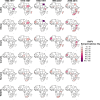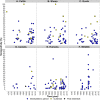Systematic literature review of Rift Valley fever virus seroprevalence in livestock, wildlife and humans in Africa from 1968 to 2016
- PMID: 30036382
- PMCID: PMC6072204
- DOI: 10.1371/journal.pntd.0006627
Systematic literature review of Rift Valley fever virus seroprevalence in livestock, wildlife and humans in Africa from 1968 to 2016
Abstract
Background: Rift Valley fever virus (RVFV) is a zoonotic arbovirus that causes severe disease in livestock and humans. The virus has caused recurrent outbreaks in Africa and the Arabian Peninsula since its discovery in 1931. This review sought to evaluate RVFV seroprevalence across the African continent in livestock, wildlife and humans in order to understand the spatio-temporal distribution of RVFV seroprevalence and to identify knowledge gaps and areas requiring further research. Risk factors associated with seropositivity were identified and study designs evaluated to understand the validity of their results.
Methodology: The Preferred Reporting of Items for Systematic Reviews and Meta-Analyses (PRISMA) guidelines were used to produce a protocol to systematically search for RVFV seroprevalence studies in PubMed and Web of Science databases. The Strengthening the Reporting of Observational studies in Epidemiology (STROBE) statement guided the evaluation of study design and analyses.
Principal findings: A total of 174 RVFV seroprevalence studies in 126 articles fulfilled the inclusion criteria. RVFV seroprevalence was recorded in 31 African countries from 1968 to 2016 and varied by time, species and country. RVFV seroprevalence articles including either livestock and humans or livestock and wildlife seroprevalence records were limited in number (8/126). No articles considered wildlife, livestock and human seroprevalence concurrently, nor wildlife and humans alone. Many studies did not account for study design bias or the sensitivity and specificity of diagnostic tests.
Conclusions: Future research should focus on conducting seroprevalence studies at the wildlife, livestock and human interface to better understand the nature of cross-species transmission of RVFV. Reporting should be more transparent and biases accounted for in future seroprevalence research to understand the true burden of disease on the African continent.
Conflict of interest statement
The authors have declared that no competing interests exist.
Figures





References
-
- Organisation WH. Blueprint for R&D preparedness and response to public health emergencies due to highly infectious pathogens: Workshop on prioritization of pathogens.http://www.who.int/csr/research-and-development/meeting-report-prioritiz... accessed 4th May 2017. 2015.
-
- Daubney R, Hudson J.R., Garnham P.C. Enzootic Hepatitis or Rift Valley Fever, An Undescribed Virus Disease of Sheep Cattle and Man from East Africa. 1931;34:545–79.
Publication types
MeSH terms
Substances
Grants and funding
LinkOut - more resources
Full Text Sources
Other Literature Sources

